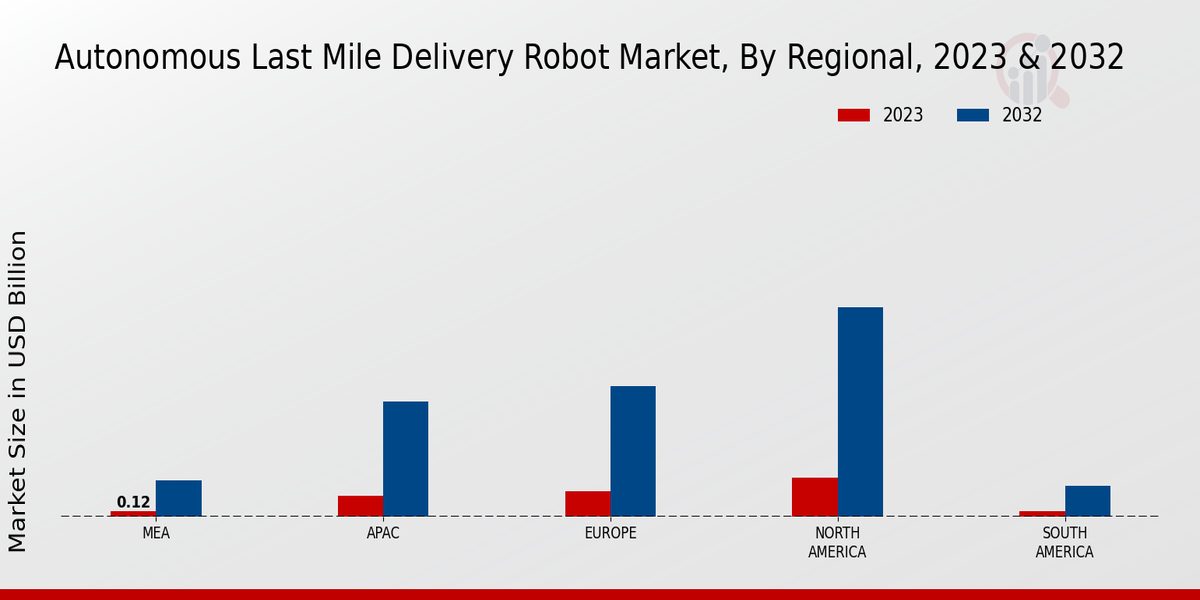Rising E-commerce Demand
The Global Global Autonomous Last Mile Delivery Robot Market Industry is experiencing a surge in demand driven by the rapid growth of e-commerce. As online shopping continues to expand, the need for efficient and timely delivery solutions becomes paramount. In 2024, the market is projected to reach 12.5 USD Billion, reflecting the increasing reliance on automated delivery systems to meet consumer expectations. Companies are investing in autonomous delivery robots to enhance their logistics capabilities, thereby reducing delivery times and costs. This trend indicates a shift towards automation in the last mile delivery sector, which is likely to play a crucial role in shaping the future of the industry.
Market Growth Projections
The Global Global Autonomous Last Mile Delivery Robot Market Industry is poised for remarkable growth, with projections indicating a market value of 12.5 USD Billion in 2024 and an anticipated increase to 45 USD Billion by 2035. This growth trajectory suggests a compound annual growth rate (CAGR) of 12.35% from 2025 to 2035. Such figures highlight the increasing acceptance and integration of autonomous delivery robots in logistics operations across various sectors. The market's expansion is likely to be driven by advancements in technology, rising consumer expectations, and the need for efficient delivery solutions. This upward trend indicates a promising future for the industry.
Sustainability Initiatives
Sustainability initiatives are increasingly influencing the Global Global Autonomous Last Mile Delivery Robot Market Industry. As environmental concerns rise, companies are seeking eco-friendly delivery solutions to reduce their carbon footprint. Autonomous delivery robots, often powered by electric batteries, present a sustainable alternative to traditional delivery vehicles. This shift towards greener logistics is supported by government policies promoting sustainable transportation. The adoption of autonomous robots aligns with global efforts to achieve carbon neutrality and reduce emissions. As businesses prioritize sustainability, the demand for autonomous delivery solutions is likely to grow, further propelling the market forward.
Technological Advancements
Technological innovations are a key driver in the Global Global Autonomous Last Mile Delivery Robot Market Industry. Advancements in artificial intelligence, machine learning, and robotics are enabling the development of more sophisticated delivery robots. These technologies enhance navigation, obstacle detection, and route optimization, making autonomous delivery systems more reliable and efficient. As these technologies continue to evolve, they are expected to lower operational costs and improve service quality. The integration of advanced sensors and communication systems allows robots to operate seamlessly in urban environments, thereby expanding their applicability. This technological evolution is likely to significantly influence market growth in the coming years.
Urbanization and Population Growth
Urbanization and population growth are contributing to the expansion of the Global Global Autonomous Last Mile Delivery Robot Market Industry. As cities become more densely populated, the demand for efficient delivery solutions increases. Autonomous delivery robots offer a viable alternative to traditional delivery methods, particularly in congested urban areas. The growing population in urban centers necessitates innovative logistics solutions to address the challenges of last mile delivery. This trend is expected to drive the market towards a projected value of 45 USD Billion by 2035. The ability of autonomous robots to navigate through crowded streets and deliver goods directly to consumers presents a compelling case for their adoption in urban environments.
Cost Efficiency and Operational Savings
Cost efficiency is a significant driver in the Global Global Autonomous Last Mile Delivery Robot Market Industry. Businesses are increasingly recognizing the potential of autonomous delivery robots to reduce operational costs associated with last mile logistics. By minimizing labor costs and optimizing delivery routes, companies can achieve substantial savings. The projected compound annual growth rate (CAGR) of 12.35% from 2025 to 2035 underscores the financial viability of investing in autonomous delivery solutions. As organizations seek to enhance their profit margins, the adoption of these robots is expected to accelerate, thereby transforming the landscape of last mile delivery.













